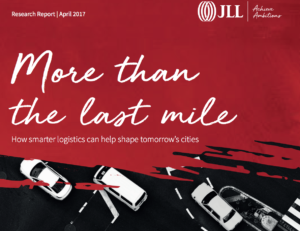Over recent years there’s been increasing interest in city or urban logistics among urban planners, developers and investors. It’s a subject which has also risen up city, national and European policy agendas. This mutual interest has been spurred by the growth of e-commerce and online retail and the burgeoning demand for last-mile fulfilment facilities being generated.
JLL latest report, ‘More than the last mile‘, seeks to give greater insight into logistics property markets by linking them to what’s happening more widely in supply chains.
Some conclusions:
Logistics in cities present big opportunities for real estate developers and investors due to strong demand and supply dynamics. JLL predicts rising demand for facilities from corporate occupiers coupled with limited land in many major cities. This will support values and overall investment performance.
City planning
Logistical considerations need to be at the forefront of city land use planning and building design.The zoning of cities and the design of buildings needs to be rethought to improve logistics efficiency and reduce congestion and disruptions. Buildings (offices, shops, hotels, hospitals etc.) are the start or end destination of most freight trips but often need to be better designed to handle freight. This is especially the case in large buildings or buildings occupied by multiple businesses, such as big office blocks or shopping centres.
City hubs
Warehouses and suitable land for logistics activities will remain critical for efficient city logistics but if these activities are pushed too far out of the cities they service, this will drive up ‘stem distances’ and, subject to the type of vehicles involved, emissions. JLL thinks there will be greater demand in and around cities for transhipment points, shared-user consolidation centres, local facilities for last-mile fulfilment including centralised facilities for ‘click and collect’, multi-modal logistics platforms and alternative modes to road transport; and multi-storey buildings. In addition JLL believe existing underground car parks in city centres could be converted into central logistics hubs, as many become surplus to requirements due to declining car travel to central and inner city areas. Electric vehicles will become much more important in city logistics, which will require significant investment in an appropriate charging infrastructure.
Multi actor – multi criteria
The varying interests of the different stakeholders in city logistics need to be addressed in order to identify new approaches that satisfy all of them. Logistics in cities involves many different ‘stakeholders’ (including city and local authorities, shippers, retailers, logistics service providers and consumers) often with different objectives and priorities. This makes it more difficult to identify and implement solutions to its challenges as each make decisions based on their own objectives. Greater collaboration between all stakeholders is likely to maximise logistics efficiency overall and minimise environmental and social impacts, but this requires a significant change in behaviour.
Check out the full JLL report on http://www.jll.eu/emea/en-gb/services/property-types/logistics-industrial/logistics-cities

